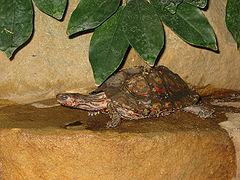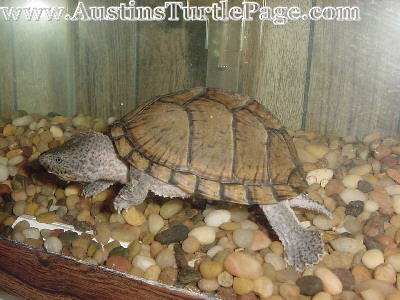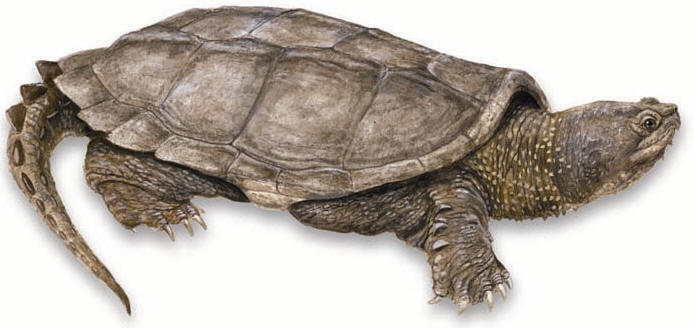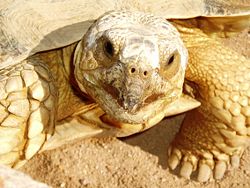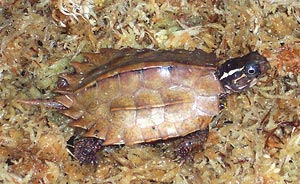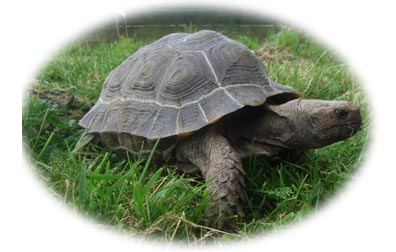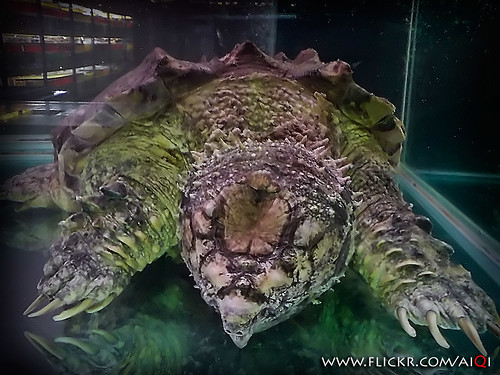Contributed by Reslider's swamp
General information
General facts about your tortoise
Classification Trachemys scripta elegans
Common name: Brazilian Tortoise, Red-eared slider turtle or Florida.
Spread
This tortoise is native to the area south of the United States and has now been found in many places
in the world. They were taken by people who buy them as pets and then released into nature
free when they have decided to no longer want to maintain it. And this causes big problems.
As happened in southern Europe, the turtles are racing to live with native turtles as a result of European
European native turtles are threatened punah.UkuranDapat grow to 30 cmKehidupanDi the wild, these turtles can
sampat lived 20 years, but in some species have been reported tangkaran can live to 40 tahun.Fisik
Dark green with yellow lines and lines have red spots on each side of the head. These turtles
can be easily distinguished by its lower jaw is more rounded than the type pseudemys more boxes. The radius
hind legs are connected by a membrane like a duck because they air.Membedakan animal sex
Males have longer claws on front paws. Cloaca on females is closer to the shell than
male. Residence
Brazil turtles are aquatic animals, so it means you need to put them in a comfortable tank that is designed
specifically to meet kebutuhannya.Jenis aquarium
Standard aquarium is the best solution to the turtle brazil, if you do not want to provide a pool outside. One
A good aspect of using a glass aquarium is that you can clean it thoroughly. Aquarium should
really clean because your tortoise health depends on cleanliness. Remember, turtles are brazil
animals and their waste water solid and liquid manure into the water, which can be a nest
both for germ bakteri.Tutup aquarium
Close the tank many variations, some are following with lights. But the most important factor
from this tank lid is to allow the entry of natural light with full spectrum. If you can,
try to get direct sunlight. Most turtle keepers of water using light spectrum
above the aquarium. Close the tank is only used if the tank is put in areas that are often exposed to wind and cold
cold drafts size aquarium
In its first year, brazil turtles grow very fast and that adults can be 10 inc. Aquarium Size
you depend on the size of the turtle and the number of turtles you have. Remember, a big plus aquariumnya,
add both to your tortoise. For adult turtles sized 5-inch, 30 gal tank is a measure of
The recommended minimum. Fill with enough water so that he can turn around if he fell backwards. About ¾ length
tortoise kura.Filter
This is very important. Health of your turtle depends on the quality of water available. Remember your tortoise alive
and breathe at the same water where they threw feces. So if the water is not clean, they will
has more germs around them and also increases the chance of disease. And if you
have a good filter, this will reduce your burden, you do not need frequent cleaning as often as without
filter. Most water turtles permelihara recommend 403.Pengahangatan Fluval filter tube and the temperature
The easiest way to keep the temperature to remain stable is to use the water heater
(Submersible heater) that looks like a long tube containing the coated wire. Type of heater is very practical because
have a thermostat you can set the temperature perfed. Keeping the temperature between 20 to 28 degrees C. This
very important because warmer temperatures raise the immune system in turtles sunning kuraDaerah
You need to provide areas within your tank where the turtles can actually become dry sunbathing
in the sun or a special lamp reptile. This is important as we have said before, warmth
the immune system raises your tortoise. And also because the turtles need UV absolute brazil
in order to process food properly and to absorb nutrients from the aquarium makanan.Dekorasi
HewanPeliharaan.Com
http://www.hewanpeliharaan.com Powered by Joomla! Generated: 17 April, 2007, 06:57
Make sure you add decorations that do not harm your turtle. If you want to add plants,
select plants that are not toxic to the turtles because they may try to eat it. Plastic plants also
not recommended. If you add the rocks, make sure the stone does not have sharp edges that can
tortoise shell scratch. Do not use sand because of the possibility of a turtle also eats batubatu
small that it can cause some serious complications. (Associated with the intestine) Cleaning
aquarium.Jaga aquariumnya so neat and clean. If you do not have the filter cleaned every two days. If
the tortoise was a baby and has no filters, clean every day. Do not use products
abresif.Pencahayaan and Heating
Brazil turtles are cold-blooded which means they depend on environmental temperature to regulate
his own body temperature. This is why the tortoise in the wild will spend her time sunbathing berjamjam
under the sun. Warmth is important for their health. Sun not only as a heat source
for the turtle but also as a source of full spectrum light from infrared to ultraviolet for the benefit of
full sun tortoise kura.Spektrum
The spectrum of sunlight consists of visible and invisible rays. White light is visible light that we receive time
all mixed into one ray spectrum. We can distinguish every color spectrum separately on
when we see a rainbow. Visible light that is between the red light to violet purple. At the moment we go beyond
we face the light rays are not visible - the sun's heat and ultraviolet. We can distinguish three
group of ultraviolet: UV-C, UV-B and UV-A
UV-C: type C UV rays are most harmful ultraviolet rays because they contain a lot of energy and
very short wavelengths (from 180 to 290 nm): they can penetrate deep enough into the tissue.
Exposed to UV-C have serious consequences on animal health: damage to the retina (blindness) is not
can be improved, skin cancer, etc.. In nature, UV-C rays are filtered by the ozone layer.
UV-B: They lie between 290 and 320 nm. UV-B rays are responsible for the skin melepuhnya
humans when exposure occurs. For reptiles are very important, especially the turtle because it requires that these rays
for synthesis. Many studies have shown an additional provision of vitamin D3 is not required in food
if the provision of UV-B rays are given every day. We remind that vitamin D3 is important to improve
calcium in bone and therefore they are important for bone formation and termpurung turtles. Layer
glass should not be installed between the sun and full-spectrum light because the glass filters UV-B rays.
UV-A: They are in a wave that is not visible to the eye from 320 to 400 nm. Although they
contains less energy than UV-B and UV-C, UV-A rays also cause sunburn / blister on
humans if exposed long enough. For tortoise UV-A visible for them. Many reptiles, including turtles
using UV-A to recognize or identify foods suitable partner. Therefore, sunbathing
under UV-A is very beneficial for the life of artificial lighting mereka.Pentingnya
You keep a turtle in an environment that is not their natural habitat is very important to provide resources
light close to natural light. Turtles need a lighting system that can produce
heat, and contain a full spectrum UVA and UVB rays. Turtles need a lighting system
which will keep the cycle of day and night and help them process the nutrients from the foods you
hot sediakan.Sumber
The point here is not to replace existing heaters provide heat in the water but in the region
berjemurnya and warm environment. The majority of the incandescent lamp (regular incandescent) or halogen lamps produce
heat. We see there is an infrared spot lights in the shops but I personally do not recommend them for kurakura:
They did not provide additional benefit as spot lights and the color is not natural. Better use
regular spot lights or a better spot lights designed specifically for reptiles (neodymium lamps). Lamp
full-spectrum fluorescent lights complements and UVA / UVB
In your store may sell a variety of full-spectrum lights specifically designed for reptiles.
Most turtle keepers recommend products like reptisun, reptistar, namiba which produces light
5% UVB and UVA 30% in addition to producing a full-spectrum light. Turn of the lights is recommended once every year
for UVB and UVA generated decreases. Creating a dry area is also needed so that your tortoise
can get out of the water and sunbathe. Please note that fluorescent lamps do not produce heat. In order tortoise
you sunbathe, you need to provide a spot light to warm the area jemurnya. Because the temperature hangatlah
that make turtles out of the water to berjemur.Lampu self-ballast mercury vapor
Lights are often missed because the price is expensive, but they are the best choices for aquaterarium
large. Not only do these lights can be a source of heat, they also provide UVB and UVA are
HewanPeliharaan.Com
http://www.hewanpeliharaan.com Powered by Joomla! Generated: 17 April, 2007, 06:57
useful. Tahannyapun power longer than other light sources. They are really designed to
a larger tank because they are only available at 100 W and 160 watts W. Be careful in the installation
because the light is very powerful and provide heat and UVA and UVB rays are quite a lot, they can
dangerous if not used with this hitamLampu benar.Lampu glow dark purple and may your
have seen these lights are often used for plants. However I personally do not recommend this lamp
for the turtles because the trial test, the lamp shows that the benefits only slightly to the tortoise and
there are some cases reported that the turtle was blinded by this light in a short time frame.
Period lighting
The point is simply to set the length of the light is on or off. If you want to make your tortoise
hibernating you must memiripkan to their natural season. For example: provide more lighting in the season
because in this hot summer sun shines longer. You can use the timer to turn on
or turn off other lights and create conditions of natural light. For example turn on the light spectrum
full for 8-10 hours and at other timer spot lights for 6 hours to equalize the hours
warmest in the day.
Filter
We can not dodge, water turtles are dirty enough, either because they were digging at the base
aquarium or her eating habits which tore the food with its claws. They also throw feces
itself into the aquarium. Therefore the water quality is fast becoming worse and these changes can be dangerous for
anda.Jenis turtle filter system which selected for the tank? Depending on the type of tank, its volume,
and interior design, berbedapun filter system can also be combined. For example for a small aquarium
no decorations other than stone used for sunbathing area, home water filters do not need replaced every day.
But this routine can be forced if you are absent a few days or you grow plants in
aquarium with sand or aquarium plus a large volumennya. Therefore, an efficient filter aquarium
into a small aquarium internalUntuk keharusan.Filter where young tortoises are maintained, internal filter
give good results. Depending on the power pump, this filter can be used for volumes up to
60 liters. Because of the small filtration volume, they should be cleaned more often, depending on the size.
Filter undegravel (under sand)
The system uses a sand filter tank itself as a media filters. Water movements generated by
air pump or water pump. Aquarium water pump (powerhead) is more efficient and ensuring clean water spreads
all the surface of the filter. Despite the controversy, this filter is a good complement for external filters
to tank the big turtles because these filters ensure the emergence of bacteria are important decomposers well
kotoran.Filter elimination of external (outside aquarium)
This filter is important if aquariumnya capacity of 100 liters or more. Because of its size, providing an external filter
combination of all filtration systems: mechanical filters, biological filters and chemical filters. Maintenance is also easy for the hand
you do not need to get into the aquarium to replace the filter medium. All you need to do is turn off
electrical filter, close the water tap in and out of the filter and you can separate the filter and clean on the other
place. Very easy. One of the advantages filters outside / external to give the room the aquarium. Filter model
now provides the largest heater in it so get the space in the aquarium. You
should choose a filtration which has a high output output to ensure a perfect filtering.
It is advisable to have a pump with its capacity of 3 to 4 times the volume of the tank in one hour. You can also
uses two filters at once if you have a tank that you have besar.Mengganti airMeskipun
using the filter, replace the water still needed. Because nitrate is produced from the decomposition of yand or will not filter
lost to efficiently without running water. It is recommended to replace water 1 / 3 of water per week. Replace with
warm water.
Food
Brazil turtles are animals that eat everything but you need to feed them with food
according Various kinds of food makananMenvariasikan very important for turtles to ensure
overall health. Do not eat just one kind only. You can give him a wide range
live food such as crickets, earthworms, snails water, cere fish, fruits, vegetables, and commercial food
vitamin.Berapa supplements often you eat
Your tortoise will always beg for food. Brazil turtles have a very large appetite.
Most turtle keepers feed the well once every two days. How much food
good? Until your tortoise full and stop eating. Other keepers feed twice a week.
I personally give them small portions of food once every day. If your turtle fat, you must
pay attention to what you give or you must start to reduce meal delivery. Commercial food
HewanPeliharaan.Com
http://www.hewanpeliharaan.com Powered by Joomla! Generated: 17 April, 2007, 06:57
There are various commercial foods for turtles. You can feed with commercial foods but
you should vary your diet. Do not just give commercial food only. Check the nutritional content
food. Preferably less than 35% protein and commercial foods that are good for the tortoise is a
containing calcium and vitamin A. VitaminAnda Supplements can provide vitamin supplements twice a week. In
most of the shops, you can see a variety of powder or liquid vitamins specially made for reptiles.
Make sure the supplement contains vitamin A, because this is very important for healthy eyes and tortoise-kura.Buah
vegetable
Most shops will tell you that brazil turtles are carnivores. Yes, they did
prefer to eat insects rather than plants, but that does not mean they do not need to eat vegetables. They do not
get enough vitamin D if only eat insects and commercial food only. You need to give him
vegetables rich in vitamin A such as carrots. Some turtles also received lettuce, tomato, papaya,
cantaloupe or bananas. Do not give him spinach or collard greens because they can cause complications
digestion. If the turtle will reject total fruit and vegetables then you only have two choices: you must
really gave vitamin supplements containing vitamin A or forced your tortoise to eat
sayuran.Tanaman airBeberapa turtles will eat aquatic plants, so if you want to decorate your tank
with them, make sure the plant is not poisonous to them. Some plants that the turtles will eat
hyacint include water, water lilies, elodia, duckweed. Feeding your tortoise with water plants
is a good idea because this plant contains vitamin A and also gave shelter to kurakura.
Cicada
Cricket is a good food for the turtles. They are a complete food and fun
see the turtles chasing them. You can get it in stores and they are relatively cheap. Or you can
mengembak sendiri.Cacing-breeding ground
Earthworms are also good food for turtles and very easily developed culture. One of the problems
is that if your turtle is still a baby, you may have to cut the worm is first before you
give him the water mereka.Keong
Natural foods are good that not only serves as a food but also as an auxiliary filter. Conch will
eat foods that your tortoise does not eat. You do not need a large aquarium to menernak
mereka.Daging raw, chicken or fish
Turtles are very like raw meat, but food is not good for turtles. Raw meat
contain too much fat and will cause obesity in turtles. Moreover they do not give
tortoise much-needed nutrients. Raw chicken meat ... be careful of salmonella. You can sometimes
give meat are cooked without seasoning. Fish, I recommend to give cere or fish guppy fish.
You can sometimes provide other types of fish but try to avoid sea fish. You should avoid giving
eat your tortoise with a fish that has been frozen previously. This prevents the fish to absorb some
nutrients and can cause problems panjang.Tulan term cuttlefish
Cuttlefish bone is also good. They are a source of calcium to the turtle and cuttlefish bone along the same
help sharpen their beaks. Cuttlefish bone can be affixed to the tank or be left floating and
let the turtle chase. You can buy it at stores including the stores of birds because they also
used to burung.Kura your turtle refuses to eat
If your tortoise previously refused foods they really like to eat it, do not worry. Tortoise
Brazil is fussy and sometimes they just want something different than the other. Sometimes
the problem is because you give him something that he prefers but does not get it and the turtle
This continues to wait until you give him food again. If the turtle refused to one type of food, try
give other foods. During the turtle is still eating something then there is no health issue that needs
feared. You should be suspicious that your turtle sick at the time he refused any kind of food you
give.
PenyakitBagaimana prevent disease
Most diseases that arise due to poor water quality, lack of adequate lighting for
sunbathing and poor nutrition.
When are you worth mecurigai the disease?
- Eyes swollen. Turtles continue to shut his eyes.
- Do not want to eat
- Changes in behavior
- Pernafasaan abnormal or runny nose
- Changes in color or white patches on the shell
HewanPeliharaan.Com
http://www.hewanpeliharaan.com Powered by Joomla! Generated: 17 April, 2007, 06:57
- DiareApa that you should do if attacked by the disease
- Rev the temperature to 23 to 30 ° C
- Keep the water to stay clean
- Continue to provide a variety of food to turtles
- Watch for unusual dirt
Symptoms and Disease
Below is a list of common symptoms and illness. Wear this as a guide and always to your doctor for
Cause akurat.GejalaKemungkinan diagnostic Jendulan tiny (tumor abcesses)
Vitamin E deficiency, problems giziTidak calm, resahMasalah intestines, constipation, detention eggs, parasites ususKurang
Almost appetite includes all of the circumstances of fatal injury Blood in the faeces of the intestine caused by
bound, septicemia, amebiasis and intestinal parasites lainnyaBernafas with open mouth Colds, pneumonia paruBerbunyi
bernafasPeradagangan time pilekPerubahan color on the carapace virus / tempurungKebanyak chlorine / chlorine in water,
nutritional problems, lack of vitamin APunggung (rachytism), carapace cacatKekurangan vitamin D3, and the lack of hy
phosphorus, less exposed to direct sunlight or UV rays, nutritional problems, the tank is too small. PyraymidingSkat (scutes)
off berjatuhanKekurangan vitamin A. If the turtles also suffer discoloration or spots like the light in
his body, attacks should dicurigaiPelunakan tempurungPunggung mycose experience rachitysm. Spots on the carapace
and kulitKekurangan vitamin A, exposed to parasites that depend on kloakaTurunnya mycetesSesuatu penis or
ususSembelit / constipation besarMasalah nutrients such as too much dry food, intestinal problems, detention
telurDiareMasalah nutrients, giving the fruit is too acid, the parasite ususPembengkakan telingaLuka purulent
caused by otitis, taxable pilekMata remove pus or water mataPeradangan pilekMata virus
exhorbitedKekurangan vitamin A, bad food - mostly fat, eyelid infection mataKelopak eye
attached to satuKeluar from hibernation, cold, or there is something in his eyes, less giziPendarahanPendarahaan
generalized but rare, red colored skin, very lesuKeracunan blood (septicemia), white or yellowish spots
within mulut.Pembusukan mouth (herpes) Mucus like yarn out of the mouth and hidungPilek, viral inflammation
pilekLumpuh (some or all of them) general trauma, fall, change the skin (shedding) that berlebihanKebanyak
chlorine / chlorine in the airBerenang resign after rubbing his head on the shell or head is always
are in tempurungnyaRasa unpleasant at the side or heavy depanBerenang sebelahRadang
the lungs (pneumonia) Esophagus bengkakPeradangan in the mouth (stomatitis), and turtles eat herpesMuntahKura
too fast, allergic reactions to medications
Vitamin deficiency (Hypovitaminosis)
On the page is a list of specific vitamin deficiency symptoms that may occur in turtles.
Vitamin A
Symptoms: eye defects, exhorbited eyes, blurred vision can make a total blindness, white patches on
shell, the loss of a portion of the skin in the neck and legs and also skating.
Prevent: Give supplement two times a week and also foods rich in vitamin A such as water hyacintch,
tomatoes, shrimp Gammarus tetra.
Treatment: injection 60-120000 IU vitamin A per kg and a second injection two or three weeks kemudian.Vitamin D3
Symptoms: The ratio of slow growth, which is not good carapace formation, inflammation of the spine (rachytism)
Prevention: Supplements vitam twice a week, ering direct sunlight or full spectrum light during
8-12 hours per hari.Vitamin E
Symptom: lumps, nodules, lipomes, abcesses of fatty tissues
Treatment: Injections of a multivitamin supplement, mengangakat wound / borokGrup Vitamin B
Symptoms: The main problem with the nervous system, lesuPencegahan: Vitamin supplements twice a week
Treatment: Injections of multivitamin supplements, fish oil (cod liver oil), organ iron ikanKekurangan
Symptoms: The defect formation and slow growth rate
Treatment: give foods rich in iron such as beef liver
Phosphorus and calcium deficiency
Symptom: If two substances are not available at the appropriate ratio, the turtle will suffer such symptoms of deficiency
vitamin D3. Keep in mind that vitamin D3 is responsible for the binding of calcium and phosphorus in
HewanPeliharaan.Com
http://www.hewanpeliharaan.com Powered by Joomla! Generated: 17 April, 2007, 06:57
bone
Prevention: Give a cuttlefish bone to your tortoise or add a vitamin supplement rich in calcium in
meals two times a week. Drying under direct sunlight or full spectrum light.
Treatment: injection multivitamin.Penyakit eye supplements
If your turtle is always close his eyes, swollen and eventually refused to eat. Possible infection
eye. The infection is caused by dirty water or lack of vitamin A. Change the water more often. Rev the temperature
to 23 to 30 ° C. Turn on the lights continue jemurnya. You can clean the eyes with water distillation and condensation
boric acid or water with salt or standard sulfamethiazine. Do it in the morning and evening. You can
use a cotton-bud to smear larutanya. Try to open his eyelids so that the solution could get into
in his eyes. Give your turtle vitamin supplements regularly. You can get these supplements in stores.
If you do not see any progress on the tortoise condition within 5 days, take it immediately to
doctor. Respiratory Infections
Symptoms: runny nose, his mouth does not completely sealed or sounds, swimming tilted to one side, listless
and would not eat.
What needs to be done: If the infection is still in the stage of mild breathing, follow these guidelines, if it is severe take
to the doctor immediately. Cover the room with tightly to avoid air impurities. Keep the water to stay warm, this is
The most important factor for the turtles to be able to fight this infection. If you have more than one kurakura,
separate the sick from the others, because this infection is contagious. If the condition does not improve within five days,
take it immediately to the shell mold dokter.Infeksi
If a turtle is like having a white coating on the shell, you can suspect a fungal infection. If the infection is
worse yet, you can follow the guidelines below, if it is severe take it to the doctor. To overcome the infection
fungi that have not been severe, bathe the tortoise with salt water for 30 minutes every day. You will see it
changes within two days and will heal within 10 days. If you do not see a change in a week,
take it to the doctor.
Soft shell
Soft shell and visible white spots. This serious condition caused by a deficiency of calcium and
lack of full spectrum light. Even if you give your turtle a diet rich in calcium
like a cuttlefish bone or calcium supplements, the turtle will not be able to process calcium properly if not
there is a full-spectrum light. If you already have a full-spectrum lights, add jemurnya time. If
software is bad or no improvement, take it immediately to the doctor.
Constipation
Causes of constipation (difficult bowel movements) is on the food. It's very easy to spot. If you notice
your time and love to eat your tortoise does not defecate, likelihood you constipated tortoise. Frequency
terngantung defecate on your frequent feeding and type of food eaten. As
general rule, if you see your turtle kicking its hind legs and tail
there is no movement of his stomach a few moments, you can guess the presence of constipation. Put the turtle in a container with
water warmer than the water that is in aquariumnya. Warmer temperatures will affect the movement
the stomach. If it does not happen, then wait 5 hours and then try again. Vary the food,
do not feed that is always the same every time.
HewanPeliharaan.Com
http://www.hewanpeliharaan.com


